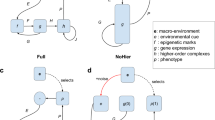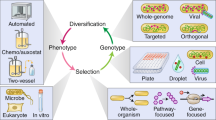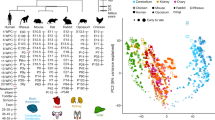Abstract
The history of life documented in the fossil record shows that the evolution of complex organisms such as animals and plants has involved marked changes in morphology, and the appearance of new features. However, evolutionary change occurs not by the direct transformation of adult ancestors into adult descendants but rather when developmental processes produce the features of each generation in an evolving lineage. Therefore, evolution cannot be understood without understanding the evolution of development, and how the process of development itself biases or constrains evolution. A revolutionary synthesis of developmental biology and evolution is in progress.
This is a preview of subscription content, access via your institution
Access options
Subscribe to this journal
Receive 12 print issues and online access
$189.00 per year
only $15.75 per issue
Buy this article
- Purchase on Springer Link
- Instant access to full article PDF
Prices may be subject to local taxes which are calculated during checkout



Similar content being viewed by others
References
Slack, J. M. W., Holland, P. W. H. & Graham, C. F. The zootype and the phylotypic stage. Nature 361, 490–492 ( 1993).
Coates, M. I. & Clack, J. A. Polydactyly in the earliest tetrapod limbs. Nature 347, 66–69 (1990).
Raff, R. A. The Shape of Life: Genes, Development and the Evolution of Animal Form (Chicago Univ. Press, Chicago, 1996).
Leroi, A. M. The scale independence of evolution. Evol. Dev. 2, 67–77 (2000).
Orr, H. A. The population genetics of adaptation: the distribution of factors fixed during adaptive radiation. Evolution 52, 935– 949 (1998).
Haag, E. S. & True, J. R. From mutants to mechanisms? Assessing the candidate gene paradigm in evolutionary biology. Evolution (Submitted.)
Smith, A. B. Dating the origin of metazoan body plans. Evol. Dev. 1, 138–142 (1999).
Mabee, P. M. Developmental data and phylogenetic systematics. Am. Zool. (in the press).
Rogers, B. T. & Kaufman, T. C. Structure of the insect head in ontogeny and phylogeny: a view from Drosophila. Int. Rev. Cytol. 174, 1–84 ( 1997).
Finnerty, J. R. & Martindale, M. Q. Ancient origins of axial patterning genes: Hox genes and paraHox genes in the Cnidaria . Evol. Dev. 1, 16–23 (1999).
Abzhanov, A., Popadic, A. & Kaufman, T. C. Chelicerate Hox genes and the homology of arthropod segments. Evol. Dev. 1, 77– 89 (1999).
Averof, M. & Akam, M. Hox genes and the diversification of insect and crustacean body plans. Nature 376, 420–423 (1995).
Grenier, J. K., Garber, T. L., Warren, R., Whitington, P. M. & Carroll, S. Evolution of the entire arthropod Hox gene set predated the origin and radiation of the onychophoran/arthropod clade. Curr. Biol. 7, 547– 553 (1997).
Weatherbee, S. D. et al. Ultrabithorax function in butterfly wings and the evolution of insect wing patterns. Curr. Biol. 9, 109–115 (1999).
Gaunt, S. J. Conservation in the Hox code during morphological evolution. Int. J. Dev. Biol. 38, 549–552 (1994).
Burke, A. C., Nelson, C. E., Morgan, B. A. & Tabin, C. Hox genes and the evolution of vertebrate axial morphology. Development 121, 333–346 ( 1995).
Cohn, M. & Tickle, C. Developmental basis of limblessness and axial patterning in snakes. Nature 399, 474–479 (1999).
Fishman, M. C. & Olson, E. N. Parsing the heart: genetic modules for organ assembly. Cell 91, 153–156 (1997).
Halder, G., Callaerts, P. & Gehring, W. J. Induction of ectopic eyes by targeted expression of the eyeless gene in Drosophila. Science 267 , 1788–1792 (1995).
Shubin, N., Tabin, C. & Carroll, S. Fossils, genes and the evolution of animal limbs. Nature 388, 639–648 ( 1997).
Gerhart, J. & Kirschner, M. Cells, Embryos, and Evolution (Blackwell, Malden, 1997).
Burndine, R. D. & Schier, A. F. Conserved and divergent mechanisms in left–right axis formation. Genes Dev. 14, 763–776 ( 2000).
Christen, B. & Slack, J. All limbs are not the same. Nature 395, 230–231 ( 1998).
Rodriguez-Esteban, C. et al. The T–box genes Tbx4 and Tbx5 regulate limb outgrowth and identity. Nature 398, 814– 818 (1999).
Grbic, M., Nagy, L. M. & Strand, M. R. Development of polyembryonic insects: a major departure from typical insect embryogenesis. Dev. Genes Evol. 208, 69–81 (1998).
Budd, G. E. & Jensen, S. A critical reappraisal of the fossil record of the bilaterian phyla. Biol. Rev. 75, 253–295 (2000).
Conway Morris, S. Why molecular biology needs palaeontology. Development S1–S13 (1994).
De Robertis, E. M. & Sasai, Y. A. A common plan for dorsoventral patterning in Bilateria. Nature 380 , 37–40 (1996).
Peterson, K. J., Cameron, R. A. & Davidson, E. H. Bilaterian origins: significance of new experimental observations. Dev. Biol. 219, 1– 17 (2000).
Jenner, R. A. Evolution of animal body plans: the role of metazoan phylogeny at the interface between pattern and process. Evol. Dev. 2, 208–221 (2000).
Rouse, G. W. The epitome of hand waving? Larval feeding and hypotheses of metazoan phylogeny . Evol. Dev. 2, 222–233 (2000).
Valentine, J. W., Jablonski, D. & Erwin, D. H. Fossils, molecules and embryos: new perspectives on the Cambrian explosion. Development 126, 851–859 (1999).
Chen, J. Y. et al. Precambrian animal diversity: putative phosphatized embryos from the Doushantuo Formation of China. Proc. Natl Acad. Sci. USA 97, 4457–4462 ( 2000).
Stern, D. L. & Emlen, D. J. The developmental basis for allometry in insects. Development 126, 1091– 1101 (1999).
Kirschner, M. & Gerhart, J. Evolvability. Proc. Natl Acad. Sci. USA 95, 8420–8427 (1998).
Wagner, G. P. Homologues, natural kinds and the evolution of modularity. Am. Zool. 36, 36–43 ( 1996).
Brakefield, P. M. et al. Development, plasticity and evolution of butterfly eyespot patterns. Nature 384, 236– 242 (1996).
Raff, R. A. & Sly, B. J. Modularity and dissociation in the evolution of gene expression territories in development. Evol. Dev. 2, 102–113 ( 2000).
Jacobson, A. G. & Sater, A. K. Features of embryonic induction. Development 104, 341– 359 (1988).
Raff, E. C. et al. A novel ontogenetic pathway in hybrid embryos between species with different modes of development. Development 126 , 1937–1945 (1999).
Acknowledgements
I thank T. Frankino and K. Wilson for helpful discussions and suggestions.
Author information
Authors and Affiliations
Additional information
Stephen J Gaunt, Babraham Institute, Babraham, Cambridge, UK
Related links
Related links
FURTHER INFORMATION
Faculty research interests at the University of Indiana
ENCYCLOPEDIA OF LIFE SCIENCES
Evolutionary developmental biology: Homologous regulatory genes and processes
Glossary
- CLADISTICS
-
An approach to inferring evolutionary relationships among organisms, on the basis of identifying shared features among diverging clades.
- HOX CLUSTER
-
A group of linked regulatory genes involved in patterning the animal body axis during development.
- MACRO-EVOLUTION
-
Evolutionary change above the species level. Evolutionary changes in populations within a species are termed micro-evolution.
- METAZOANS
-
Multicellular animals.
- ONTOGENY
-
The course of development in an organism from embryo to adult.
- PHYLOGENETICS
-
The study of evolutionary relationships among organisms.
- TETRAPOD
-
Four-legged vertebrate animals.
- FIXATION (OF AN ALLELE)
-
When an allele replaces all other alleles in a population, so that its frequency is equal to one (that is, 100%).
- EPIGENETICS
-
Events in development that depend on interactions with other parts of an embryo or the environment.
- HALTERES
-
In Diptera (true flies), the second or hind wings have become modified into a pair of club-like balancing organs called halteres.
- SOMITES
-
Axial blocks of mesoderm along the vertebrate body axis that further differentiate into dermal skin, bone and muscle.
- PROTOSTOME/DEUTEROSTOME
-
The two principal divisions of animal phyla, based on how the mouth forms in the embryo.
- BASAL MEMBERS
-
Lineages or branches that diverge at the base of a phylogenetic tree; more primitive lineages.
- BILATERIAN
-
Animals with bilateral body symmetry.
- CNIDARIANS
-
Radially symmetric animals such as jelly fish, corals, hydra and anemonies.
- CAMBRIAN EXPLOSION
-
The rapid diversification of animal life observed in the fossil record in rocks of early-mid Cambrian age (540–530 million years ago). Many of the major phyla that characterize modern animal life evolved at this time.
Rights and permissions
About this article
Cite this article
Raff, R. Evo-devo: the evolution of a new discipline. Nat Rev Genet 1, 74–79 (2000). https://doi.org/10.1038/35049594
Issue Date:
DOI: https://doi.org/10.1038/35049594
This article is cited by
-
Genome Wide Association Studies of Early Fitness Traits in Drosophila melanogaster Unveil Plasticity and Decoupling of Different Aspects of Phenotype
Evolutionary Biology (2024)
-
Patterns of ontogenetic evolution across extant marsupials reflect different allometric pathways to ecomorphological diversity
Nature Communications (2023)
-
Evolution of post-weaning skull ontogeny in New World opossums (Didelphidae)
Organisms Diversity & Evolution (2018)



